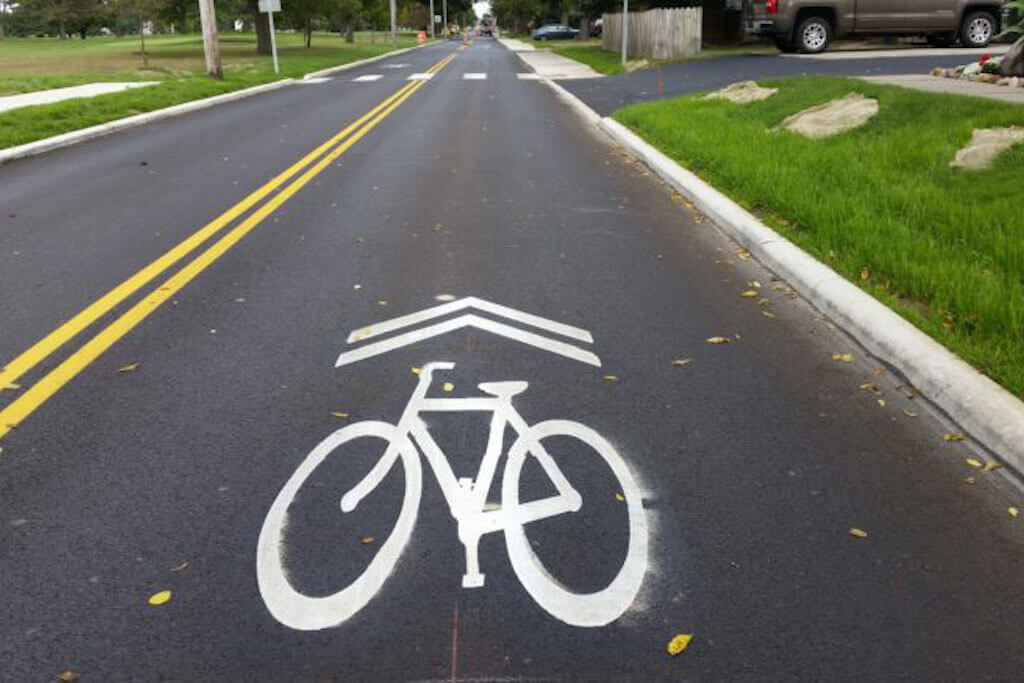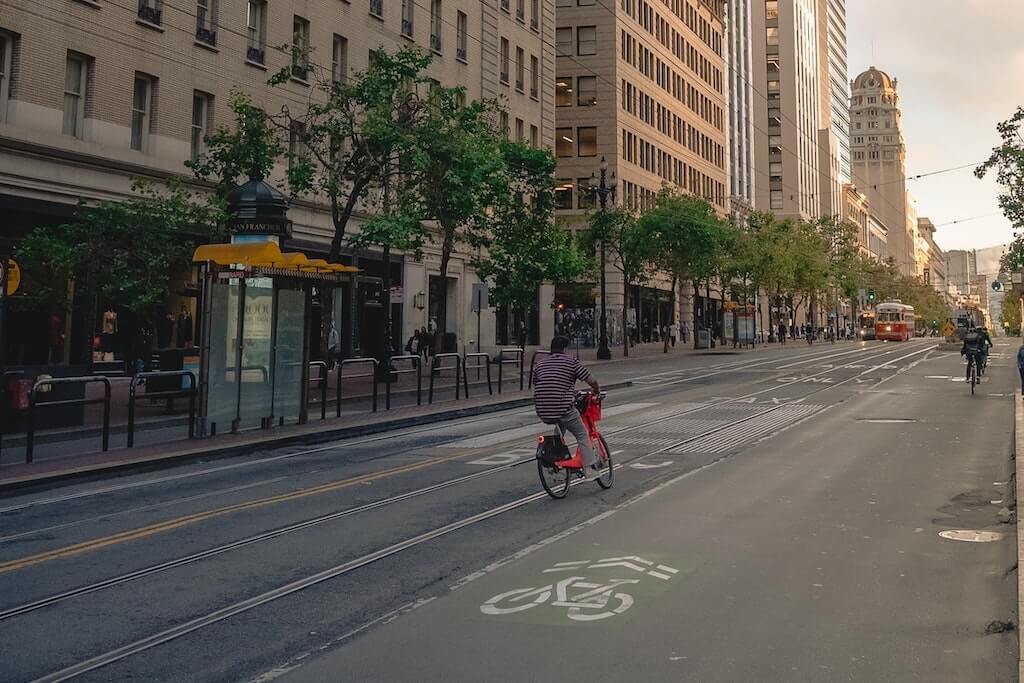Autumn Gear Guide
Find inspiration in our Gear Guide that will keep you out on your bike through wind or rain.
Download NowAre you tired of feeling like you’re playing a real-life version of Mario Kart while biking through your city? Do you long for a safe, stress-free ride where you can pedal along without fear of getting flattened by a speeding car? Well, my fellow cyclists, I’ve got some good news and bad news for you. […]
Are you tired of feeling like you’re playing a real-life version of Mario Kart while biking through your city? Do you long for a safe, stress-free ride where you can pedal along without fear of getting flattened by a speeding car? Well, my fellow cyclists, I’ve got some good news and bad news for you.
Let’s start with the bad news: painted bike sharrows are basically useless. If you’re unfamiliar with these sad, lonely symbols, they’re those little bike-shaped icons painted onto roads that are supposed to indicate where cyclists should ride. But in reality, they’re about as effective as trying to protect yourself from a charging rhino with a wet paper towel.
Studies have shown that sharrows don’t actually provide any real safety benefits for cyclists. In fact, they may even make things worse by encouraging drivers to pass cyclists too closely. It’s like trying to protect yourself from a swarm of angry bees with a sign that says “Please don’t sting me.” It’s just not going to work.
People For Bikes senior director Dave Snyder was one of those in the old-timey days who believed sharrows might be the answer. Put symbols on roads so car drivers understand that they are sharing the road and to watch out for cyclists. But we all know that there is no watching out.
Snyder recently published an honest editorial about his experience in the late 1990s as the former executive director of the California Bicycle Coalition — a key player in the proliferation of shared lane markings.
“Looking to those examples from Chicago, Paris, and Denver, we pushed to get an improved version of the sharrow design formally included in the city’s bike plan and approved for use by the state of California,” Snyder wrote. “Mayor Willie Brown famously painted the first sharrow on Grove Street outside of City Hall, getting some green paint on his fancy suit and laughing it off in his inimitable style.”
Snyder witnessed San Francisco splashing down its sharrow symbols on road after road after road.

Do you know where to ride your bicycle (or car) when you see this symbol?
The idea was simple enough, short for share arrow, the sharrows indicate a zone on the road where cyclists would not get doored by people getting in and out of their cars. It’s not a bike lane. It was never a bike lane. It was only a guide, used ideally on quiet neighbourhood streets with low speed limits, to indicate some form of a safe cycling route and to indicate to car drivers to give cyclists more room.
The problem was and continues to be that some jurisdictions use them instead of bike lanes because they are so easy to install. Not to mention, car drivers just don’t seem to pay attention at all anyway.
“I thought the sharrow would educate bicyclists to stay out of the ‘door zone’— the three or so feet of space adjacent to parked cars where motorists opening car doors and bicyclists could collide — and usher in a new era of safer streets, one where motorists would patiently wait behind bicyclists “taking the lane” because this painted symbol made it clear they had the right to do so,” he wrote. “Where we couldn’t get a bike lane, I hoped this symbol would effectively convert the mixed-traffic lane into an ad-hoc bike lane when bicyclists were present.”
He was wrong, which he readily admitted, in the editorial.
We know now that even actual bike lanes painted in some eye-catching hue do not provide enough safety for cyclists.
Time and time again, research demonstrates that sharrows are ineffective at improving cyclist safety. In fact, a study published in the Journal of Transport and Health found that sharrows provide no significant safety benefits for cyclists. This is because they do not provide physical separation between cyclists and vehicles, leaving cyclists vulnerable to accidents and injuries.
Furthermore, sharrows can actually make things worse. The same study found that sharrows can lead to a false sense of security for both cyclists and drivers. Cyclists may ride closer to parked cars, increasing the risk of collisions with opening car doors. Meanwhile, drivers may pass cyclists more closely, putting cyclists in even more danger.
Snyder suggests there over the years there have been some studies that indicate a marginal benefit of sharrows, but too little by any meaningful safety measure.
“It’s been more than 20 years since I had high hopes for the sharrow as a tool for safety,” he wrote. “Today, we know so much more about what it takes to make our streets safer for bicycling. We need separate bike paths; we need protected bike lanes on busy roads; and where the lanes are shared, we need actual speeds reduced to 20 mph or slower. Sharrows don’t do any of that.”

San Francisco
So, what’s the alternative? The best bicycle infrastructure for safe cycling is dedicated bike lanes that provide physical separation between cyclists and vehicles. These lanes can be separated from traffic by curbs, bollards, or planters. A study from the University of British Columbia found that protected bike lanes reduced the risk of injury for cyclists by 90 percent compared to riding in mixed traffic.
Protected bike lanes provide a safe and predictable route for cyclists, reducing the likelihood of accidents and injuries. They also increase the visibility of cyclists, making it easier for drivers to see and avoid them.
It’s not just about safety, either. Bike lanes have been shown to have a positive impact on the economy, too. In New York City, for example, businesses along protected bike lanes have seen a 49 percent increase in sales, compared to just a 3 percent increase for businesses without bike lanes.
It is also the number one reason why people take up cycling in the city for transportation as opposed to recreation — separated, and safe cycling infrastructure. So if we want to encourage people to leave their cars at home to cut greenhouse gas emissions, there is only one way to move the needle.
A study from Ryerson University showed that building safe and protected bike lanes makes people almost twice as likely to cycle.
Despite the overwhelming evidence in favor of protected bike lanes, many cities continue to rely on painted sharrows. This may be due to a lack of funding or political will, or simply a lack of awareness about the benefits of protected bike lanes.
Some actually count the miles of sharrows in the overall expansion of the bicycle network. So, a city that claims to have expanded its cycling network by a surprising amount might be counting some painted arrows as legitimate infrastructure. Great cycling cities do not use sharrows. The end.
“We never suggest using sharrows to create a bikeway,” Snyder concludes. “We’ve learned our lessons. Now that we know better, it’s time to do more.”
If you’re looking to bike safely through your city, the best option is to use dedicated bike lanes that physically separate cyclists from vehicles. Painted sharrows provide little to no safety benefits and may even be counterproductive. Protected bike lanes, on the other hand, provide a safe, predictable, and enjoyable experience for cyclists while also providing economic benefits for local businesses and combatting the climate crisis.
It’s time for cities to invest in protected bike lanes and prioritize the safety of cyclists on our roads.
Find inspiration in our Gear Guide that will keep you out on your bike through wind or rain.
Download Now
Leave a comment